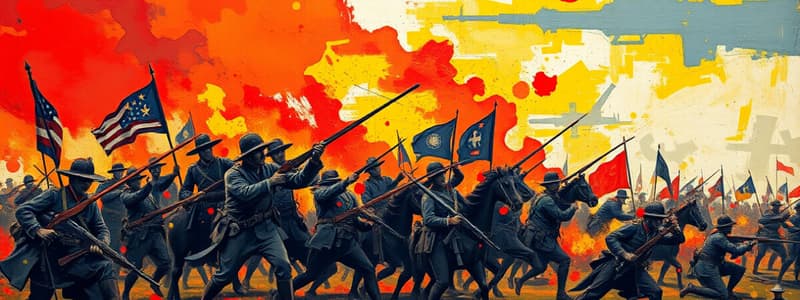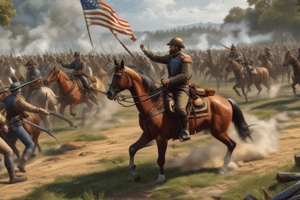Podcast
Questions and Answers
What was the significance of the Battle of Antietam?
What was the significance of the Battle of Antietam?
- It led to the issuance of the Emancipation Proclamation. (correct)
- It was the first major battle of the war.
- It resulted in a significant strategic victory for the Confederacy.
- It was the last major battle fought in the North.
What was one outcome of the Union victory at the Battle of Vicksburg?
What was one outcome of the Union victory at the Battle of Vicksburg?
- It effectively split the Confederacy in two. (correct)
- It immediately led to the end of the war.
- It granted the Union control over the city of Atlanta.
- It allowed the Confederacy to maintain control of the Mississippi River.
Which battle is considered the turning point of the Civil War?
Which battle is considered the turning point of the Civil War?
- Battle of Vicksburg
- Battle of Bull Run
- Battle of Gettysburg (correct)
- Battle of Atlanta
Which strategy was NOT employed by the Union during the Civil War?
Which strategy was NOT employed by the Union during the Civil War?
What was one of the primary tactics used by General Sherman in his military strategy?
What was one of the primary tactics used by General Sherman in his military strategy?
Which Confederate strategy aimed to secure foreign support?
Which Confederate strategy aimed to secure foreign support?
What was a key feature of the Anaconda Plan?
What was a key feature of the Anaconda Plan?
Which battle demonstrated the idea that the war would be longer and more brutal than initially expected?
Which battle demonstrated the idea that the war would be longer and more brutal than initially expected?
How did the Union victory at the Battle of Atlanta contribute to their overall strategy?
How did the Union victory at the Battle of Atlanta contribute to their overall strategy?
Which Confederate strategy involved launching occasional attacks while primarily focusing on defense?
Which Confederate strategy involved launching occasional attacks while primarily focusing on defense?
Flashcards are hidden until you start studying
Study Notes
Key Battles and Strategies of the Civil War
Major Battles
-
First Battle of Bull Run (July 1861)
- First major battle of the war.
- Confederate victory; boosted Southern morale.
- Showed that the war would be longer and more brutal than expected.
-
Battle of Antietam (September 1862)
- Bloodiest single-day battle in American history.
- Draw, but considered a strategic Union victory.
- Led to the issuance of the Emancipation Proclamation.
-
Battle of Gettysburg (July 1863)
- Turning point of the war.
- Union victory; halted Lee's invasion of the North.
- Significant casualties on both sides; led to increased support for the Union cause.
-
Battle of Vicksburg (May-July 1863)
- Key to the Union’s control of the Mississippi River.
- Union victory; split the Confederacy in two.
- Lasted over 40 days, showcasing effective siege tactics.
-
Battle of Atlanta (July-September 1864)
- Union victory under General Sherman.
- Crucial for the Union’s control over Georgia and railroads.
- Led to Sherman’s "March to the Sea" strategy.
Key Strategies
-
Union Strategies
- Anaconda Plan: Developed by General Winfield Scott; aimed to suffocate the Southern economy through blockades and control of the Mississippi River.
- Total War: Used by General Sherman; aimed to destroy the South’s will to fight by targeting military and civilian resources.
- Capture of key cities: Targeting major Southern cities to disrupt supply lines and communication.
-
Confederate Strategies
- Defensive War: Focus on defending territory rather than aggressive offensives, hoping to outlast Northern resolve.
- Cotton Diplomacy: Attempt to leverage cotton trade with Britain and France to gain support and recognition.
- Offensive-Defensive Strategy: Occasionally launching attacks (e.g., Gettysburg) while primarily defending their territory.
Impact of Battles and Strategies
- Battles shaped military tactics and strategies throughout the war.
- Each significant battle influenced public opinion and political decisions.
- The strategies employed by both sides evolved in response to successes and failures on the battlefield.
Major Battles
-
First Battle of Bull Run (July 1861)
- Marked the war's first significant combat; Confederate forces emerged victorious.
- Confederate win elevated Southern morale, indicating a prolonged and fierce conflict ahead.
-
Battle of Antietam (September 1862)
- Recorded as the bloodiest single-day battle in U.S. history, with substantial casualties.
- Resulted in a strategic Union victory despite being categorized as a draw; catalyzed the Emancipation Proclamation.
-
Battle of Gettysburg (July 1863)
- Considered the war's turning point as it halted General Lee’s northern campaign.
- Union victory resulted in heavy losses for both sides, bolstering Northern resolve and support for the Union cause.
-
Battle of Vicksburg (May-July 1863)
- Crucial for Union dominance over the Mississippi River, effectively splitting the Confederacy.
- Featured a prolonged siege lasting over 40 days, highlighting the effectiveness of Union strategies.
-
Battle of Atlanta (July-September 1864)
- Led by General Sherman, this Union victory was pivotal for controlling Georgia's key infrastructure.
- Set the stage for Sherman’s infamous "March to the Sea," emphasizing a strategy of total war.
Key Strategies
-
Union Strategies
- Anaconda Plan: Conceived by General Winfield Scott; aimed at strangling the Southern economy via naval blockades and capturing the Mississippi River.
- Total War: Implemented by General Sherman, targeted both military and civilian resources to erode Southern morale and capabilities.
- Capture of Key Cities: Focused on major Southern urban centers to disrupt supply lines and hinder Confederate communication.
-
Confederate Strategies
- Defensive War: Primarily sought to protect territory, banking on outlasting Northern resolve without extensive offensive maneuvers.
- Cotton Diplomacy: Attempted to utilize cotton supplies to incentivize support and recognition from Britain and France.
- Offensive-Defensive Strategy: Engaged in sporadic offensive actions, like at Gettysburg, while mostly focused on territory defense.
Impact of Battles and Strategies
- Major battles significantly influenced military tactics, reshaping strategies employed by both armies.
- Each battle played a role in swaying public opinion and prompting political actions.
- Adaptation of warfare strategies by both sides was a response to battlefield successes and failures.
Studying That Suits You
Use AI to generate personalized quizzes and flashcards to suit your learning preferences.




